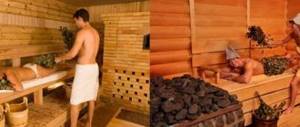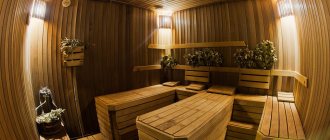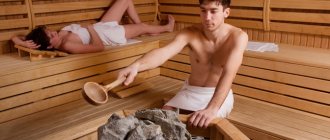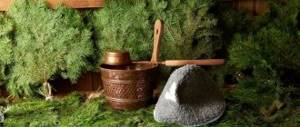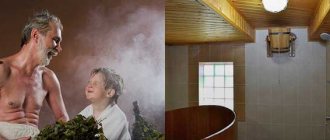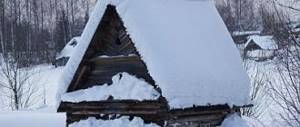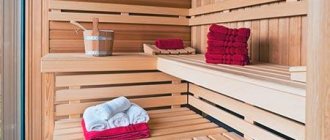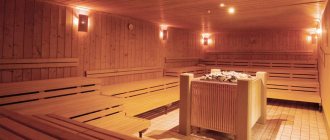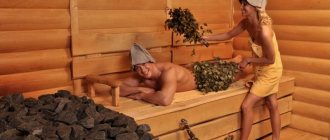The day you sweat, the day you don’t grow old. (Russian proverb)
Going to the bathhouse is a serious matter, it requires preparation and experience, and knowledge of some tricks. The noble Bath Attendant will share the secrets of light steam, good mood and the rules of bath etiquette and “fashion”.
- To the steam room without haste and fuss! There is no benefit from steaming in a hurry; a bathhouse is a holiday, a pleasure and a healer. Set aside a few hours, or even an evening, in your schedule for this ritual.
- Choosing a bathhouse Among the many bathhouses, everyone will find their ideal one. The Finnish sauna is hot and dry, the eastern (Turkish) hammam is with wet and soft steam, the Russian bath is universal - both in terms of steam and degree of heating.
- There is only a shower or a swimming pool in front of the steam room. Set aside the washcloth and soap for later. You should prepare for a visit to the steam room by standing under a warm shower for several minutes. You can swim in the pool for 15-20 minutes, if possible. This way the muscles become toned, improving the benefits of the steam room. And it’s better not to get your hair wet; usually a bath cap is slightly moistened.
- In a sauna with a pillow It is better to steam while lying down, relaxing and forgetting about everything. People who understand comfort will choose a felt pillow instead of a hard wooden headrest.
- Rule of a safe bath A good bathhouse attendant warns guests and resolutely will not allow razors, alcohol, or even glass bottles with essential oils and gels to be brought into the steam room.
- Nothing extra. Believe the people's experience: before taking a steam bath, watches, glasses, and all jewelry must be removed. They can deteriorate and burn you inadvertently.
- Give me a couple! You should splash on the stones to produce steam with boiling water or a hot infusion of herbs with oils and aromatic additives, water with kvass and beer. The stones are not poured, but served in small portions, at the very heat of the stove. Hear a pop from the stones - this is a sure sign of light, soft steam. But in order not to get burned by a wave of hot air, you need a ladle with a long wooden handle.
- After the steam , we took a steam bath, warmed up under the brooms, now move to the lower shelves. The pulse will calm down a little, the head will clear, then you can leave the steam room. Moderation and restlessness in the bathhouse are the key to health.
The health benefits of Russian baths
The benefits of the Russian bath are as follows:
- the body is freed from waste and toxins, due to which the skin is cleansed, the so-called orange peel disappears, and the condition of muscles and bone tissue improves;
- intense sweating promotes weight loss;
- blood circulation improves;
- blood pressure stabilizes;
- headaches and migraines disappear not only during a visit to the steam room, but also after it;
- immunity is strengthened;
- the functioning of internal organs, the condition of blood vessels, breathing and smell improves.
This result is achieved due to favorable conditions in the steam room - this is the optimal ratio of temperature (from 55 to 75 degrees) and humidity (from 45 to 65%).
Always clean glass of the remote firebox door
At this point we will not tell you how to clean glass; We will tell you how to eliminate the cause of its contamination.
Glass that gets dirty quickly is a sign of using damp wood. Wet wood not only clogs the door glass, but also accelerates the accumulation of soot on the chimney walls, which requires more frequent maintenance and shortens the life of the pipes.
When using dry firewood, you will get rid of the problem of frequent glass contamination and extend the life of your chimney. Dry firewood will also help you reduce fuel consumption and optimize the combustion process. Firewood with a moisture content of no more than 20% is considered dry.
When using damp wood, combustion will partly expend energy on evaporation of moisture in the wood. And when using dry wood, the gases contained in it will burn.
Contraindications and possible harm
Despite all the benefits, the procedure also has serious limitations. Contraindications to visiting the steam room are as follows.
- Pathologies of the epidermis and rashes on the skin. Even if you have small pimples, you cannot steam, otherwise an abscess will arise with all the ensuing (literally and figuratively) consequences.
- Cardiovascular and pulmonary failure. It is also recommended that people suffering from sexually transmitted pathologies, pneumonia, bronchitis, epilepsy and cancer, both malignant and benign, refrain from visiting the bathhouse.
- Children's age up to 5 years. Everything is clear here - the baby’s body is not yet able to withstand such temperature overloads. Elderly people can only take a steam bath after a doctor’s permission.
- The period of bearing a baby and breastfeeding.
The procedure itself does not cause harm to health if there are no contraindications to its implementation and if you know how to take a steam bath in a Russian bath and what attributes to take with you to the steam room.
What material to choose for walls
The modern building materials market offers various options suitable for building a bathhouse to suit every taste. The most common: wood, concrete blocks and brick.
Since ancient times, construction has been carried out from wood as the most environmentally friendly material that does not require additional finishing. Wooden walls delight with a pleasant aroma and aesthetic appearance.
Types of bath brooms and their effects on the body
A broom is an indispensable attribute of a Russian bath. Professionals know that each attribute affects the body in its own way and has its own distinct effect. There are several types of bath brooms.
- Birch. It is in greatest demand among lovers of the Russian steam room. Birch leaves contain tannins, vitamins and essential oils. This composition determines the anti-inflammatory, disinfecting and antimicrobial properties of the broom. It is recommended for use in a steam room by heavy smokers and people with lung pathologies. Birch broom also improves the condition of the epidermis: promotes rejuvenation and cleanses the skin.
- Oak. This is the second most popular attribute of the Russian bath. It is recommended for use by people with inflamed and oily epidermis. Broom is useful for hypertensive patients because it stabilizes high blood pressure, but not during an exacerbation. Broom leaves contain tannins, so they relieve a person from excessive sweating.
- Lime. Linden leaves have anti-cold and anti-inflammatory properties. The substances they contain improve the quality and duration of sleep, and also relieve migraines, headaches and improve the condition of the epidermis.
- Cheremukhovy. The leaves contain substances that promote the healing of small wounds on the epidermis. The broom has a pleasant aroma, making a visit to the steam room an aromatherapy session. The bird cherry broom is very soft, so it is in demand among girls and women.
- Juniper. It has a positive effect on the state of the nervous system and normalizes unstable emotional background.
- Walnut. Experts recommend using it for people suffering from diabetes. The broom also improves the condition of varicose veins and ulcerative pathologies.
- Fir. Helps remove excess fluid from the body. Due to this, swelling from the face and limbs disappears. Fir broom has sedative and anti-inflammatory properties. It relieves insomnia and radiculitis.
- Alder. Alder leaves contain adhesive substances, due to which during the procedure they stick to the epidermis and free it from waste and toxins. Broom has a positive effect on the respiratory system.
- Nettle. Helps cure radiculitis and arthritis. Stabilizes high blood pressure and normalizes unstable emotional background.
- Eucalyptus. Helps get rid of colds. A broom also helps eliminate allergies.
Protecting sauna lining from moisture
The most difficult path is a tile border, over which there is already a lining. As a result, moisture does not come into direct contact with the wood.
Sometimes it is advised to mount the lining horizontally, so that later you can replace the bottom strip.
The first method is labor-intensive, and the second still requires further intervention.
The best protection against moisture is to choose wood that is not susceptible to change when exposed to moisture. This could be Canadian cedar, hemlock, Finnish pine.
If your lining is not ready for the moisture test, then you can use a little advice when installing the lining.
It is necessary to nail the bottom strip at a distance of 3-4 cm from the floor so that it does not touch the floor. The space under this plank can either be left uncovered, or the rest of the lining can be stuffed in there, which can then be covered with a plinth. Instead of the rest of the lining, you can use any strip that matches the thickness of the lining used.
Necessary accessories for the procedure
In addition to a broom, to visit the bathhouse you will need:
- bathrobe;
- large towel;
- rubber slates;
- sheet;
- felt or wool hat;
- clean linen;
- hard mitten;
- washcloth;
- shampoo;
- soap or shower gel;
- drinks: tea, juice, decoction based on medicinal herbs, pure water without gas.
Representatives of the fair sex are recommended to take with them anti-cellulite products (if they have the problem of “orange peel”) and creams for the face and body.
It is not recommended to take alcoholic drinks with you to the bathhouse, as they create an increased load on the heart, which can cause a heart attack and other pathologies.
Construction materials for baths
Before starting construction, you should prepare all the necessary materials. In addition to what you need for the walls, you need to purchase everything you need for the roof, foundation and finishing. You will definitely need:
- batten;
- ceiling boards or lining 20 mm or slightly thicker;
- lining for wall decoration;
- vapor barrier film for roofing;
- waterproofing film;
- mineral wool for ceiling insulation;
- asbestos sheets for insulating walls near the stove and chimney;
- sand-gravel mixture and cement for foundation work;
- roofing material;
- insulation for walls (if the bathhouse is made of timber or logs).
The constructed bathhouse cannot be used immediately, as it must settle. Therefore, it is recommended to begin construction in early spring.
How to take a steam bath correctly: the main steps
How to properly steam in a bathhouse with a broom - professional steamers know the intricacies of this procedure, but not all ordinary people know. On the day of visiting the steam room, it is recommended to avoid salty and fatty foods. Three hours before leaving home, you are allowed to have a light snack, for example, cottage cheese with a low mass fraction of fat.
Preparing for a visit to the steam room
Before entering the steam room, experts advise taking a warm shower. This manipulation will warm up the skin and prepare it for exposure to elevated temperatures.
When taking a shower, do not use detergents or rub your body with a washcloth. Such manipulations lead to the washing away of the protective layer from the epidermis, which causes the skin to dry out during a visit to the steam room.
You should also not wash or wet your hair, as this increases the risk of heat stroke. To avoid this, people enter the steam room only with a dry head covered with a special cap. If it is not possible to purchase one, you can make a headdress yourself using natural fabrics: wool, felt, linen and others.
First run
During this session, the body gets used to the conditions of the steam room - to elevated temperatures and humidity. It is recommended to take a broom with you and soak it in hot water. It is not recommended to use the attribute on the first pass.
When in the steam room, sit on the bottom shelf. There is not such an acute lack of oxygen here as at the top, and the temperatures below are not as high. It is recommended to steam in a lying position. Place a sheet on the shelf, lie down and try to relax. Breathe deeply and evenly. When your heart rate increases and your cheeks become red, move to a higher level.
The duration of the first run is 10 minutes.
Visit with a broom
On the second pass, you can use a broom.
- Lightly pat the broom over the body from top to bottom. Move slowly so as not to injure the epidermis, but to prepare it for further manipulation.
- Raise the broom high above your head. A large amount of steam is concentrated at the top, which will warm the leaves. Apply the attribute briefly to the face, chest, abdomen and back, as well as to the feet.
- Lightly pat the broom over the body. Movements should not be unpleasant or cause pain.
- Move the broom over the body for a minute, but do not pat. After this, alternate stroking and patting, but make the movements more intense.
- Heat the broom again, holding it above your head. Apply the attribute to your face, chest, stomach, back and feet for 5 seconds.
After using the broom, rest on the bench in a lying position for three seconds. Then leave the steam room. The number of such visits is from 4 to 7. The duration of stay in the steam room is no more than 25 minutes.
Breaks
It is recommended to take breaks between the first and subsequent visits to the steam room. Their duration should be longer than the time spent in a room with elevated temperatures. You can’t steam longer than rest.
During your stay in the steam room, the body leaves a large amount of liquid. This helps the swelling go down, but can also cause dehydration. To prevent this from happening, you need to drink warm tea, herbal decoctions, juices or water between sessions.
Completing the procedure
Before the last approach, it is recommended to rub the body well with a hard mitten. This will help open the pores, and the procedure will be more beneficial. Representatives of the fair sex can put a mask on their face. After the steam room, wash it off, wash your head and body using shower gel or a mala and a washcloth.
LiveInternetLiveInternet
The history of the Russian bathhouse is probably much deeper than we can imagine. For some reason, many people underestimate the civilization of the Russian people, believing that their entire history, upon closer examination, turns out to be a real chronicle of savagery and backwardness. How wrong they are, these skeptics! In fact, the Russian bathhouse is perhaps the most ancient, since its appearance dates back to approximately the same period as the very birth of the Slavic tribe! There was also no written language as such, but we already see in oral folk art references to the bathhouse and its healing power
After all, the bath procedure seems to combine the two most powerful natural elements - fire and water. The ancient Slavs, as you know, were pagans in their beliefs and worshiped a wide variety of gods. And the most “strong”, therefore, the most revered were the god of the sun and fire and the goddess of rain and water. By combining these two forces during the bath procedure, the ancient Slavs seemed to attract them to their side and thus took over part of their power. The pagan holiday of Ivan Kupala, by the way, is also rooted in the depths of ancient Slavic beliefs. By jumping over fire, our distant ancestors tried to “burn out” evil and disease and cleanse their souls. And nightly swimming in a river or lake personified unity with Mother Nature and communion with her vital forces. In almost all epics and tales we can see echoes of ancient beliefs in the healing and cleansing power of water. Our ancestors knew that health is associated with cleanliness. The legends about “dead” and “living” water that emerged from such “vague guesses” tell us that pure “living” water has healing powers. The bathhouse was considered the guardian of “living” water and health, since it seemed to strengthen and direct a person’s vital energy in the right direction. The bathhouse was first considered a symbol of overcoming everything bad that can surround a person in earthly life, and in later times it became the personification of friendliness and homeliness. In Russian fairy tales, Ivanushka demands that Baba Yaga first steam him in a bathhouse, feed him, give him something to drink and put him to bed, and then ask him questions. These ideas about hospitality have been preserved in villages to this day, and now a guest who knocks on the door will first of all be offered a steam bath, and then offered a table and a bed. The bathhouse has always played such an important role in the life of Russian people that in the ancient chronicles of the 11th-12th centuries, which tell about the customs of the “Russians,” we often find references to “soaphouses.” The baths were called “soaps”, “movnits”, “movyu”, “vlazny” and “movny”. Even in the treaty with Byzantium (dating back to 907), the Russians specifically stipulated that the Russian ambassadors who arrived in Constantinople would “create language” whenever they wanted. Baths are mentioned both in the “Tale of Bygone Years” (945) and in the charter of the Kiev-Pechersk Monastery (966). In those ancient times, the monks of the Kiev Pechersk Lavra were very well informed in matters of medicine, since they had the opportunity to read the works of ancient Greek physicians, and it was Greek medicine that first drew attention to the benefits of the steam bath. In an effort to verify the information they had received, the monks began to build baths and observe the healing effect they had on the sick and “suffering.” When the medicinal properties of the baths were fully confirmed, something like hospitals began to be set up at the baths, and such baths were already called “institutions for the infirm.” These were probably the very first hospitals in Rus'. The Russian bath cannot be compared with either European or Asian baths. The Russian bathhouse, in contrast, has a much stronger effect with its heat. An indispensable attribute of the Russian bath - a birch broom - whips hot bodies with all its might. It seems that this is not a bathhouse, but torture. This is what foreigners who found themselves in a real Russian bathhouse thought at all times. In the steam room, under the blows of the brooms, it seemed to them that “their death had come and was standing on the threshold.” But after the bathhouse, foreigners noted that they felt great. The amazing, thrilling sensations associated with a Russian bath remain forever in the memory of foreigners. The fame of the Russian healing bath is spreading throughout the world. In many foreign books of antiquity and the present day, travelers share their impressions of Russia. Is it possible to understand the Russian character without visiting a Russian bathhouse? Russian baths with their healing powers have won the love of many people outside our country. Fans of Russian baths are building them in both France and America. Once in Canada, our compatriot can relieve his soul in the Sandunovskie baths. They were built according to the prototype of the Sandunovsky baths in Moscow. The attractive power and healing ability of Russian baths are generally recognized. One of the ancient Arabic manuscripts preserves the memory of one traveler who visited Rus' and took a steam bath. From this source it became known how our ancestors arranged baths: “... They built a small wooden house. It had only one small window, which was located closer to the ceiling. All the cracks between the logs were caulked with tree resin mixed with forest moss. In one of the corners of the hut there is a fireplace surrounded by stones. There was also a large barrel of water in the bathhouse. When the fire flares up, the stones are sprinkled with water, and the door and window are sealed.” The Russian bathhouse amazed the imagination of foreigners who were accustomed to baths with warm water. Therefore, the Russians, who dived into the ice hole after a scalding bathhouse, were seen by strangers as heroes. The structure of the baths did not undergo any changes for a long time, and it remains so to this day. The idea remained the same, but its implementation has changed. Initially, the baths were a small wooden hut, built from solid logs. They tried to place bathhouses near reservoirs so as not to experience difficulties with water. The internal structure of the bathhouse is as follows: approximately a third of the entire room is occupied by a stove-heater. A fire is lit below, which heats the stones placed on top, and also heats the bathhouse. When the stones are hot, the fire is extinguished, the pipe is closed with a damper and steamed, pouring water over the stones to create steam. They soar by climbing onto shelves (emphasis on the second syllable), which are something like a ladder with four or five wide steps. The higher a person climbs on the shelves, the hotter and more “vigorous” the steam is. On the last shelf, almost under the ceiling, only the hardiest and strongest steamers, who don’t mind 100-degree heat, risk steaming. This is the so-called white bath. At first it was built only from logs, but then brick baths appeared. We find the first mention of a brick bathhouse in the chronicle of 1090, and it was built in the city of Pereyaslavl. If there is a white sauna, then, naturally, there must be a black sauna, attentive readers will say and they will be absolutely right! There was such a bathhouse. At first, even before the appearance of white bathhouses, the Russian people heated their bathhouses in black style for centuries. There are few real experts of such a bath now, but this idea does not fade away. There is a fairly widespread misconception that steaming black means suffocating from soot and burning in a small room next to an open stove. Of those who think so, there is not a single person who has experienced first-hand what a black bath is. There is no need to be afraid that they will soon stop worrying about everything. There are many places throughout Russia where preference is given to the original Russian tradition. Bathhouses in the villages of the Middle Urals, Western Siberia and other places were built in accordance with the behests of their ancestors, who knew a lot about a real bathhouse. They say there: “The black bath will wash you white
So what is the difference between a black bath and a white one? Only in the method of heating the room. After all, the house itself (both for a white and a black bath) was built the same way and was very small. There were only two small rooms with a rather low ceiling. The height of the ceiling corresponded to the height of an adult man. The small size of the bathhouse made it possible to heat it properly. The main difference between a black-heated bathhouse and all others is the absence of a chimney. The door to the bathhouse was made very strong, without cracks. To ensure that it closed tightly and there was no draft, a wooden step was made in front of the door. The first room of this bath house is called the dressing room. It was equipped with maximum amenities. In the dressing room there was a bench and a clothes hanger. The dressing room is significantly smaller in size than the bathhouse itself, from which it was separated by a thin wooden partition. They preferred to make such a partition from linden or pine. The partition had a door that closed tightly, thereby preventing smoke and steam from entering the dressing room. In one of the corners of the bathhouse there was a stove on which large round stones-boulders lay. Next to the stove there was a tub with a large supply of water. The bathhouse had one small window, and it was located above the stove. Thus, the bathhouse could be ventilated as needed. As already mentioned, the stove in the black bath was without a chimney, so the smoke and soot went directly into the steam room. Naturally, after the first attempt to heat the bathhouse in this way, the walls and ceiling of the steam room became sooty, and this soot was completely impossible to remove. It was for this black color of the walls and ceiling that the bathhouse began to be called black. After the sauna is heated, all windows and doors are opened so that the smoke comes out and the air in the steam room becomes fresher. Of course, no one started steaming until all the smoke had disappeared, otherwise one could easily get burned in such a bathhouse. Having ventilated the bathhouse, it must be prepared so that you can steam in it. To do this, the bathhouse is “steamed”: a special scraper is passed along the walls, excess soot is washed off by dousing the walls with hot water from a bucket, and only after these manipulations they are “steamed” by splashing water on the heater. This method of steaming is called “black”. It is the most ancient and originates, figuratively speaking, in the Russian oven. After all, long before baths appeared, Russians were steaming in stoves. How did this happen? Quite simple, but nevertheless very witty. They used the absolutely remarkable property of the Russian stove to retain heat long after food was cooked or bread was baked. Having removed the soot and ash from the mouth of the stove, they tried to wash the walls, laid straw on a tray, placed a tub of water there and placed a broom. Next, help was required: the one who steamed first sat on a shovel or even on an ordinary board, and an assistant carefully pushed him into the mouth. The oven damper closed tightly, and the person began to steam. By sprinkling water on the walls of the oven, you got an absolutely wonderful fragrant steam with the smell of just baked bread. When the steamer wanted to get out of the oven, he knocked on the damper, and he was taken out of the oven in the same way as he was placed there. In general, this process was very similar to baking bread: like a loaf, they “put” a person in the oven, and when he “brown” from the heat, they quickly took him out. Having steamed, the person doused himself with cold water, and if there was a river nearby, he ran and plunged into the river. Most likely, bathing with hot water was not very common; much more often they simply took a steam bath, alternating this with cold douches. But they washed their hair in a very strange way (in the modern sense). Wood ash was first used to wash hair! Or rather, not the ash itself, but the so-called lye, which was made from ash. Only then did they begin to wash their hair with eggs; it is this ancient method that has survived to this day. And now many beauties, wanting to preserve the beauty and shine of their hair, wash it with an egg in the old fashioned way. Isn’t this the best confirmation of the wisdom of our ancestors, when a modern person thoughtfully refuses fashionable patented cosmetics, preferring instead folk remedies that have been tested for centuries! If we want to trace the entire “path” of development of the Russian bathhouse, it will be like this: first - a Russian stove, in which they could steam after cooking and baking bread. Then the cramped mouth of the stove “expanded” to the size of a dugout, which was heated in the black way. The heater as such had not yet appeared; instead, in the center of the dugout there was a pile of stones, on which they splashed water. Smoke came out not only through the entrance hole of the dugout, but also through cracks in the roof. Then the cramped and low dugout “grew up”, becoming a small house, half dug into the ground. Such black baths were heated by stoves and already had a separate stove and several shelves. And only after this the Russians began to equip their black baths with chimneys so that the smoke would not accumulate in the steam room, but would go outside. This is how white baths appeared - first wooden, and then stone. But with the advent of the white bathhouse, the black bathhouse did not lose its position - they began to exist simultaneously. To this day, in many villages you can find bathhouses that are heated both white and black. Russians have always been very democratic and therefore tried to take into account the interests of all residents of a village, town or city, building two types of baths. After all, there are still people who like black saunas much more. They claim that the steam in a black bathhouse is more fragrant and beneficial than in a white one, because only in a bathhouse heated in the old way does a special, some ancient feeling of home comfort and warmth remain. Probably, these were the feelings that primitive hunters experienced when they returned from hunting: all the hardships are behind them and they can finally relax and unwind, enjoying the peace. And modern man, whom civilization has freed from the harsh need to fight wild animals and the elements for his existence, sometimes simply needs to feel like an ancient hunter and warrior, capable of hard physical labor. After all, let’s be honest, our male contemporaries have become more effeminate compared to their courageous ancestors. And the black bathhouse, with its primitive sensations, apparently awakens in them some kind of ancestral, genetic memory, which, as it were, returns them to those harsh times. And it's so great! Having briefly felt like a warrior, a man tries to retain this feeling within himself: when he knows that a lot depends on his courage and determination, he behaves completely differently. He actually becomes more courageous, some special calm dignity appears in him, that brutality that is gradually being lost in our refined, civilized society. That's for sure. Tested in practice! Actually, this, of course, is not a scientific theory - about genetic memory, which is “awakened” by a hot Russian bathhouse, heated using the black method. But something really happens to them (to men, in the sense) because they come out of the Russian bathhouse somehow different! If you want to check it out, go to some remote village where an old black bathhouse is still preserved. It is guaranteed that your civilized companion, whose most “bloodthirsty” act was cutting up the meat fillet you bought in the supermarket, after visiting the black sauna, will express an ardent desire to go hunting. You will simply be amazed to the core by the changes that have taken place. And besides, after such a bath something happens to the body: it becomes more obedient, almost animal-like flexibility and grace appear, and the whole body becomes ten years younger! Marvelous! And doctors have found a scientific explanation for the “life-giving” properties of the black bath: it turns out that the smoke contains special antiseptic substances that destroy pathogenic bacteria and microbes. This is why the black sauna is so beneficial
Of course, now not everyone has such an opportunity to experience the effects of a black bath for themselves, and not everyone can withstand it. Let’s be honest, if you’re not used to a black sauna, you won’t get burned for long, especially if a person has never taken a steam bath in a sauna before! But anyone can take a steam bath in a white bathhouse: it is both pleasant and no less useful. The original Russian white bathhouse looked nondescript from the outside. The wooden hut stood half-grown into the ground. This prevented the winds from blowing through the bathhouse, thereby quickly cooling it. In addition, such a “down-to-earth” location of the bathhouse was very convenient for the correct placement of the stove and chimney. Unlike the black bathhouse, this one had a chimney above it. The bathhouse was divided into two parts. The dressing room (the smaller part) was arranged according to tradition simply, but taking into account the needs. The bathhouse itself, or steam room, occupied the largest part. Its main attraction was the stove with a chimney. The stove, the heart of the bathhouse, had several levels. The lowest level was a small recess - a vent. There was a stove above it. There were chimneys running from the stove in the wall. And on the stove there was a layer of stones. A tub of water next to the stove allowed steam to be added as needed. This design of the stove provided good “draft” during combustion, as well as ventilation for the bathhouse. Very often, for this reason, steam rooms in a white bathhouse were without windows. The air in such a bath is always saturated with oxygen. It is no less hot than in a black sauna, but not as hot and tart. In such a bathhouse, combustion products are practically not felt in the air, and only the aromas of wood, broom and medicinal decoctions predominate. There is no doubt that those who experience breathing difficulties due to any illness cannot do without a white-heated bathhouse. The pure aromatic steam of such a bath has a cleansing effect on the lungs. Breathing in an aromatic bath is similar to inhalation. Such baths became the prototypes of modern baths, which inherited their healing power from traditional Russian baths. Among bathhouse lovers there are a lot of creative and inventive people who use their knowledge to bring the ancient design of the bathhouse as close as possible to modern conditions. And this is very important, because more and more often people use not a bathhouse, but a bath or shower. Most people now have little opportunity to have their own wooden bathhouse. But the state provides support for the construction of public baths. Many enterprises, stadiums and holiday homes have first-class baths. They are lined with wood and give wonderful steam. Often buildings that were not originally intended for these purposes are equipped with bathhouses. There are baths in basements and stone buildings. In such cases, it is somewhat more difficult to achieve real vigorous steam, especially if the walls of the bathhouse are tiled. In addition, public baths usually attract a lot of people. Evaporation from many hot bodies affects air humidity. Baths with high humidity are more difficult for humans to tolerate than dry baths. The temperature in them is not high. Of course, the steam effect in such baths remains strong, but it is more difficult for the skin to cleanse itself and “breathe.” There are often public baths in which there is no heater, and steam enters the steam room through a pipe from the utility room where the stove is heated. Technical delivery of steam to the steam room is the brainchild of civilization. It is good because by moving the valve you can reduce or increase the steam supply. Many people love baths very much, but public baths do not bring them the desired pleasure. Such people should not give up their dream of owning a bathhouse. Try to find a way out: build a bathhouse based on your means and territorial capabilities. The minds of many engineers were occupied by the design of a modern bathhouse. This is how options for installing a bathhouse in a city bathroom appeared. With some effort and skill, a bathhouse in a city apartment can be of excellent quality. First, you should think about wall paneling in your bathroom. Birch boards can be used for this. Knock down removable shields from the boards. Thus, you can turn your bathroom into a bathhouse by “dressing” the walls in fragrant wood. Secondly, make a wooden shelf and mount it into the wall above the bathtub. You can make the shelves removable or foldable. You can't do without a heater in a real bathhouse. This can also be arranged in a city apartment. Place the mini-electric oven flush with the shelf. Place the required number of round stones in a metal bowl and place on the electric stove. The heat from the heated oven affects the stones. By spraying hot stones with water, you will get real steam. In the case of a mini-electric oven, you should be especially careful and careful
When organizing such a bath, ensure the safety and serviceability of the electrical wiring and sockets. A “bare” contact in contact with water can cause a short circuit and even a fire. Plug sockets and switches are absolutely not suitable for such a bathhouse. They are too dangerous. In order to avoid serious problems during the design and construction of a bathhouse, contact the services of fire service specialists. The air of a city bath can be given a fragrant and healing aroma of plants by placing a bouquet of herbs near the ceiling. You can also pour a herbal decoction into the bath. The healing aroma, rising, will affect your body and make breathing easier. Another way to steam in a city bathroom is quite simple, but effective for some diseases of the musculoskeletal system or if you want to lose excess weight. For this you will need two wooden frames. They should be knocked down with a “lattice”. One of them will serve as a bed. The second will serve as a seat back. The frames should follow the shape of the bathtub and be firmly fixed in it. Fill the bathroom with a small amount of hot water - about 5-6 liters. Secure the frame made of a “lattice” at a distance of 20-25 cm from the water. The person wishing to take a steam bath is placed on this frame. A second frame is installed under the back and head. Thus, the person is above the water, which floats. To complete this bath design, you need to cover the bath with a thick sheet. Do this carefully so that no steam escapes. Thus, only the head does not take a steam bath in such an extravagant bathhouse. The steam in the enclosed space of the bath is quite tart, and this enhances the healing effect of the bath on your body. The proposed design is quite economical. Of course, it can’t compare with a real bathhouse, but still something! A real Russian bathhouse is now a great luxury. There are few people left willing to heat the stove with wood or coal. In addition, most people have a bathhouse in their country house. Therefore, they have little time for “bath preparations”. You can speed up the process of heating a bath using new technologies. Perhaps precisely because most bathhouses now run on electricity or gas, it is possible to take a steam bath in a black-heated bathhouse only in villages. The traditions and knowledge that a “black” bathhouse washes white are still alive there. Country bathhouses are also a good way out of the “bathhouse” crisis. A bathhouse in a country house can be very tiny, designed for 2-3 people to steam in it. Wealthy people can afford a grandiose bathhouse with a relaxation room, a swimming pool, a shower, etc. You can build a separate bathhouse or place a bathhouse under the same roof as a summer house. You can use any material for the construction of a bathhouse, based on your own considerations in this regard. It is enough to cover the steam room with wood, and then the aroma of the tree will become the spirit of your bath. You can also avoid problems with high air humidity. A small bathhouse is built in Russian traditions: a dressing room and a steam room. A more expanded version of the bathhouse includes a larger number of rooms, the first of which is the hallway. Street shoes and outerwear are removed in this room. The next room is the dressing room, or dressing room. Here a person is freed from underwear. There is only one way from the dressing room - to the bathhouse directly. In some cases, it is arranged taking into account all the bathing preferences of the owner. In the central hall of such a bath there is an average temperature and little steam. There are benches or beds. You can wash yourself in this room. It is also better to do a massage here, because the air temperature here is very suitable for this procedure. From here you can enter the dry heat and steam cabin. The steam room is heated with hot air, it enters through pipes and is regulated by a valve. In addition, there is a heater in the steam room, which is heated using an electric stove, so you can always use the steamer if you wish. The wonderful Russian tradition of plunging into cold water after a bath is also implemented in the modern version of the bath. If possible, you can arrange a swimming pool next to the bathhouse. Its design should allow you to frequently change the water in the pool. It should also have a heating system - this will help you create the desired water temperature in the pool. In addition to the pool or instead of it, you should build a shower at the bathhouse. Build a special shower stall for it with cold and hot water supply. It is very convenient to use a mixer tap in the shower, which allows you to take a shower with water at the desired temperature. The relaxation room is a place to have a pleasant time after the bath. The arrangement of this room remains the owner's priority. What can you not imagine relaxing after a bath without? A TV, a refrigerator with beer, a samovar, a sofa and much more can be found in the relaxation room at your request. Time has not left the bathhouse without technical changes. The properties of the bath remain the same, but the design itself changes, adapting in detail to the new time. This applies not only to the mass of amenities with which modern people are accustomed to surrounding themselves. Changes have also occurred with the stove. Not everyone wants to make the bath heating process gas or electric. There are also those who like to take a steam bath and prefer the stove. The modern version of the sauna stove has become more complicated due to the details. The firebox must have a blower, which makes it easy to remove ash from the stove. The blower became much longer than it was before. It also provides draft, without which the fire in the stove would be weaker. Chambers with stones, which are used to generate heat, are protected by a layer of sand. Sand protects stones from rapid cooling and reduces heat loss. The structure of the bathhouse chimney is very similar to the indoor chimney structure. The only difference is that the chimney recess above the stove itself is made wider and filled with stones. The more stones, the hotter the sauna will be. The stove has been laid by master stove makers for a long time. And now there are no shortage of such specialists. Therefore, if you do not consider yourself a master of the stove business, seek help from a person who knows this delicate matter. Sometimes ignorance of the exact technology for building a bathhouse does not lead to the results that were expected. So, when building a bathhouse on your summer cottage, you need to try to foresee all the surprises and not fantasize with construction technology, but strictly follow the instructions of specialists and always remember the folk wisdom: WHO DOES IT AT CHANCE, AT LEAST THROW EVERYTHING SOON TO PEOPLE TO LAUGH. BRAVE DANILO FORGES AND BLOWS, AND HIMSELF DOESN’T KNOW WHAT WILL HAPPEN. But having already built the bathhouse, it will be possible with a clear conscience to collect bath accessories and heat it hotter, as they say, “on the first run.”
Post author: ariskveda
How useful are contrast procedures?
After high temperatures, the epidermis needs cooling. A Russian person who practices hardening can allow himself to dive into an ice hole and rub himself with snow. If you do not have such experience, it is recommended to simply stand under a cool shower or swim in the pool.
After multiple visits to the bathhouse, you can try going outside and drying yourself with snow. After some time, dipping into the ice hole is allowed.
Construction of walls and installation of roofing
The most common material for bathhouse walls is 150x150 timber. The first crown is treated with special antiseptic substances and placed on waterproofing.
More often, the timber is connected “into the paw”. The first crown is checked for the presence of right angles, then the assembly of the walls begins. Each crown is laid with a layer of thermal insulation and connected with iron or wooden pins.
After the walls are erected, the rafters are mounted using metal brackets. The roof of a bathhouse most often has a gable shape. In this case, the rafters rest on the walls and are connected at the top into a ridge. Lathing is installed on the rafters, then steam and waterproofing layers, and insulation. Finally, the roof is installed.
Important Tips and Recommendations
Important recommendations on how to take a steam bath.
- After leaving the steam room, it is not recommended to immediately take a vertical position on the bench or even lie down. You need to walk around a bit for your body to come to its senses. You can't move fast. Walking slowly for 5 minutes will help the body adapt to new conditions. After this you can sit down and relax.
- You cannot use cosmetics before visiting the steam room. They clog pores. This worsens the quality of your stay in the steam room. Cosmetics also prevent the epidermis from absorbing the beneficial substances contained in broom leaves.
- If you feel worse, you must immediately stop the procedure and leave the steam room. In the dressing room the body will cool down and the condition will return to normal. On this day, it is recommended to refuse subsequent steam rooms. If the situation repeats when you go to the bathhouse again, such manipulations should be abandoned.
Massage techniques using a broom
First of all, learn how to work with two brooms. This massage technique is the most effective. Hands with brooms move alternately with the required intensity and impact force, while the brooms are directed not parallel, but crosswise. Thus, one area of the body receives a double blow. Using two brooms, stroke along the body and circular massage of individual areas, when the hands, squeezing the handles, describe circles in the opposite direction. Some techniques involve synchronous movement of the hands, for example, when pumping hot steam to heated areas of the body.
Let's try to describe all the known methods of manipulating a broom in a steam room:
- Plowing or warming up. The broom captures the most heated steam from the ceiling and, with swinging movements, directs it to the body of the steamer, barely touching the skin. Warming usually begins with the feet, pushing hot steam towards them, and gradually moves along the legs, buttocks, lower back, back, and so on up to the neck-shoulder girdle;
- Shaking. The broom is shaken vigorously several times under the ceiling of the steam room to heat it up and then the hot leaves are quickly and briefly (1-2 seconds) pressed against different parts of the body: feet, legs, lower back, shoulder blades, neck, shoulders;
- Whiplash. Quite noticeable biting blows with a broom with an amplitude of up to 1 m. This technique is especially effective when working alternately with two brooms;
- Compress. The bathhouse attendant lifts the broom up to warm it up, and then quickly applies it to the body of the steamer and presses it on top with his hand in a mitten for 4-5 seconds. An extremely effective method, especially for the prevention of radiculitis and osteochondrosis. They start, as always, with the feet. It is believed that warming up the feet triggers the acceleration of metabolism. Particular attention is paid to problem areas: lumbar region, spine, neck, shoulder joints, forearms;
- Stroking. A well-heated broom with slight pressure is slowly passed along the entire body from the feet to the neck and this technique is repeated several times. Stroking is performed in the same way on the hands and even on the face;
- Quilting. This technique consists of a combination of alternating stroking and whipping. Once you get used to it, this type of massage is also more convenient to perform with two brooms.
Possessing such a rich arsenal of various techniques, an experienced bathhouse attendant can not only improve your well-being, invigorate and lift your spirits, but also put a real barrier to the development of many diseases. And you, having adopted this skill, will also be able to bring a lot of pleasure and benefit to other people.
After the massage, do not rush to get up from the bench, lie down and rest for 2-3 minutes. Only then slowly, without making sudden movements, rise and leave the steam room. In the bathhouse, everything should be done slowly.
